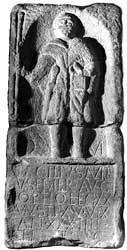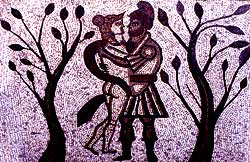|

Click on the image for a larger version.
|
Image
details:
The tombstone of Caecilius Avitus, optio
in the XXth legion based at Chester. In his left hand he carries
a case of stylus tablets,in his right a a staff.
The inscription reads:
D(is) M(anibus) / Caecilius Avit / us Emer(ita)
Aug(usta) / optio leg(ionis) XX / V(aleriae) V(ictricis) st(i)p(endiorum)
XV uix(it) / an(nos) XXIIII / h(eres) f(aciendum) c(uravit)
To the spirits of the departed, Caecilius Avitus from Emerita
Augusta, optio of the 20th legion Valeria Victrix, of 15 years’
service, lived 34 years. His heir had this erected.
Image ownership:
Grosvenor Museum, Chester |
We have already seen how closely the army monitored its men and
materials through the use of documents and how official and personal
communications were conducted through writing. A late Roman writer
comments on the numbers of documents that were produced by the military
bureaucracy:
'For the administration of the entire legion, including special
services, military services and money, is recorded daily in the
Acts with one might say greater exactitude than records of military
and civil taxation are noted down in official files. Daily even
in peacetime, soldiers take it in turns from all centuries and 10-man
sections to do night watch duties, sentry duty, and outpost duties.
The names of those who have done their turn are entered in lists
so that no one is unjustly overburdened or given exemption. When
anyone receives leaves of absence and for how many days, it is noted
down in lists.'(Vegetius, Epitoma rei militaris, 2.19,
trans. Milner).
Soldiers seconded to clerical duties were part of any garrison.
Clerical staff and archives were probably based in the tabularium,
in the principia. This was supervised by the cornicularius
(301),
assisted by his deputy (actuarius) plus clerks (librarii).
Also in the principia was the office of the standard bearers, responsible
for financial affairs. Officers are also likely to have had a share
in the bureaucratic tasks. We can sometimes calculate how many records
might have been produced, and how many have perished. Between the
reigns of Augustus and Diocletian (27BC - AD 305) the army may have
produced as many as 225,000,000 pay records, of which three survive
in reasonable condition.
No such clerks are explicitly identified in the Vindolanda tablets,
but the presence of scribes is indicated by a difference between
the hand that writes the body of a letter and the hand that finishes
it (291). Among the letters of Cerialis
seven different hands have been identified, one of which is plausibly
his own. The skills of literacy were not exclusive to clerks. As
well as the prefects themselves, members of their households were
also capable of writing documents. The correspondence of Lepidina
reveals letters written to and by women: indeed the closure of Severa's
invitation to Lepidina is the earliest recorded Latin handwriting
by a woman (291). Slaves writing letters
appear also to belong to such households (301,
347). The standard forms submitted
by junior officers reporting 'all present and correct' reports are
all written in different hands, as too are requests for leave submitted
by individual soldiers. Civilian traders also made extensive use
of documents. Overall, the existence of several hundred different
hands among the Vindolanda documents testifies to the widespread
use of writing.
Latin
Before Vindolanda military documents on papyrus and ostraka had
been excavated in the south and east of the Roman empire, at Dura
Europos on the Euphrates in Syria, from several sites in Egypt and
at Bu Njem in Libya. These sites were in areas that had long traditions
of literacy, albeit mostly in Greek rather than in Latin, the language
of the army. The pre-conquest peoples of Britain and northern Gaul
were almost entirely non-literate.
Documents from Vindolanda and Carlisle show that recruits from
such areas had acquired a competence in reading and writing Latin
nevertheless one or two generations after the conquest of their
homelands. The Latin written at Vindolanda is standard for the period,
with some elegantly written examples, especially in the correspondence
of Cerialis (225),
although there are exceptions in which the Latin is poorer (343).
There is little detectable trace of the native languages of the
Vindolanda units. Some Celtic words occur that had long been borrowed
into Latin, for example cervesa (beer), raeda (carriage)
or sagum (cloak). Other Celtic words in the tablets represent
borrowed terms that are less well known, for example bedox
(192)
and tossea (192,
439),
terms for textiles.
Other languages were surely spoken at Vindolanda, including the
Germanic and Celtic languages of the garrison homelands and the
Celtic language(s) of the British tribes. On Hadrian's frontier
the linguistic mix was drawn from the entirety of the Roman world.
As well as those of western Europe, Greek, the languages of Syria,
Palmyra and North Africa, as well as the Danubian provinces (Illyrian,
Thracian, Dacian) would also have been heard. In this polyglot world
Latin was the lingua franca. Service in the army was one
route by which Latin spread to different parts of the empire.
Education

Click on the image for a larger version.
|
Image
details:
Dido and Aeneas take refuge from a storm
in the cave. The scene is taken from a fourth century AD mosaic
from Low Ham Roman villa, Somerset, which depicts several
episodes from Virgil's Aeneid
Image ownership:
Vroma, Photo Barbara McManus, Taunton County Museum |
The army seems the most plausible context in which most of the
soldiers would have learnt Latin. The sharing of script and conventions
among the tablets, including layout, abbreviations,
symbols and punctuation, as well as the correct, sometimes archaic,
spelling, indicate the probable existence of a scribal training.
Otherwise an education in Latin was available only to those rich
enough to afford it. From Britain evidence for schools is scarce,
although Tacitus tells us of Agricola's encouragement of education
among the indigenous elites (Agricola, 21. trans Mattingly):
'furthermore he trained the sons of the chiefs in the liberal arts
and expressed a preference for British natural ability over the
trained skill of the Gauls. The result was that in place of distaste
for the Latin language came a passion to command it.'
For the few to whom education was available, basic training in
reading, writing and arithmetic was followed from the age of 11
or 12, studying Latin and possibly Greek grammar, literature, history
and philosophy, with the grammaticus and later the rhetor.
This was intended to cultivate the skills of public speaking necessary
to advance in civic life. It is plausible that individuals such
as Cerialis had had such an education, and there is possible evidence
for teaching Latin at Vindolanda, perhaps by a tutor in the household.
118
and 452
have lines from books one and nine of Virgil's Aeneid. This epic
poem described the foundation of Rome and was the core 'set-book'
of the Roman curriculum. Perhaps there was a copy of the poem at
Vindolanda, used in the education of Cerialis' children. These scraps
are perhaps the remnant of writing exercises (see also 119),
while another text refers to books, libros (333).
Graffiti and artistic evidence, for example mosaic depictions also
show that Virgil was known in the provinces. Reading matter at Vindolanda
potentially included the highest products of Latin literature as
well as writing tablets, graffiti and inscriptions. The education
to which high social status gave access perhaps inculcated the values
of Rome in the native elite, through studies of set books like Virgil's
Aeneid, a 'mission statement' for Rome's role. The same education
also instilled esteem for appropriate literary conventions and elegant
expression.
|